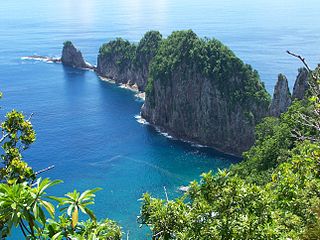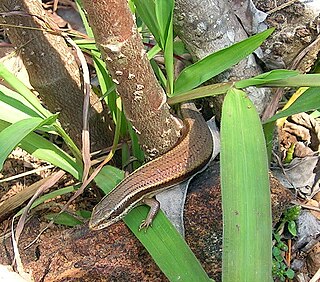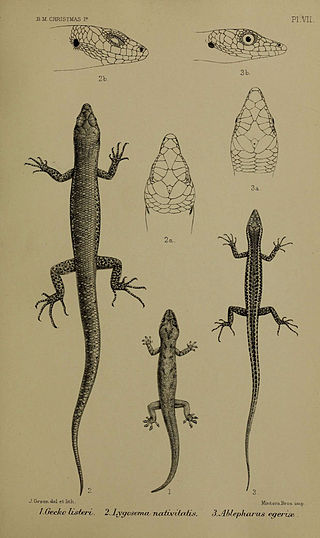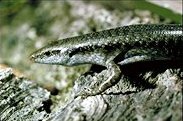
Emoia is a genus of skinks, lizards in the subfamily Eugongylinae. The genus Emoia belongs to a group of genera mainly from the southwestern Pacific-Australian region.

The National Park of American Samoa is a national park in the United States territory of American Samoa, distributed across four islands: Tutuila, Ofu, Olosega, and Ta‘ū. The park preserves and protects coral reefs, tropical rainforests, fruit bats, and the Samoan culture. Popular activities include hiking and snorkeling. Of the park's 8,257 acres (3,341 ha), 2,500 acres (1,000 ha) is coral reefs and ocean. The park is the only American National Park Service system unit south of the equator.

Vostok Island is an uninhabited coral island in the central Pacific Ocean, part of the Line Islands belonging to Kiribati. Other names for the island include Anne Island, Bostock Island, Leavitts Island, Reaper Island, Wostock Island or Wostok Island. The island was first sighted in 1820 by the Russian explorer Fabian Gottlieb von Bellingshausen, who named the island for his ship Vostok.

The Henderson crake or red-eyed crake is a species of flightless bird in the family Rallidae. It is endemic to Henderson Island in the southeast Pacific Ocean. Its natural habitat is dense to open forest.

Lygosominae is the largest subfamily of skinks in the family Scincidae. The subfamily can be divided into a number of genus groups. If the rarely used taxonomic rank of infrafamily is employed, the genus groups would be designated as such, but such a move would require a formal description according to the ICZN standards.
The family of Northwest Solomonic languages is a branch of the Oceanic languages. It includes the Austronesian languages of Bougainville and Buka in Papua New Guinea, and of Choiseul, New Georgia, and Santa Isabel in Solomon Islands.
There are two species of skink named copper-tailed skink:

Emoia caeruleocauda, commonly known as the Pacific bluetail skink or Pacific blue-tail skink, is a species of lizard in the family Scincidae. It is widespread in the Indo-West Pacific.

The Christmas Island forest skink, also known as the Christmas Island whiptail skink, is a species of skink formerly endemic to Australia's Christmas Island. As of 2017, it is listed as extinct on the IUCN Red List. The last known forest skink, a captive individual named Gump, died on 31 May 2014.

Emoia impar, also known as the dark-bellied copper-striped skink, or the azure-tailed skink is a species of skink that is widespread in the Pacific, especially Polynesia and Micronesia.
Emoia sanfordi, known commonly as Sanford's emo skink and Sanford's tree skink, is a species of lizard in the family Scincidae. The species is endemic to Vanuatu.

Steindachner's emo skink, Micronesian skink, dark-sided emoia, dark-sided skink, or dateline emoia is a species of lizard in the family Scincidae. It is found in Micronesia. The species has also been noted to occur on Niuafoʻou, the northernmost island of Tonga, with sightings in 1930 and 1994. The species is not present on other Tongan islands, and is possibly present due to waif dispersal occurring during Polynesian migration.
The Micronesia black skink is a species of lizard in the family Scincidae. It is found in Micronesia, likely limited within the Marshall Islands, Nauru, and Kosrae. There is debate on whether the Nauru population is a subspecies, due to its larger amount of middorsal scales.

Emoia boettgeri, also known commonly as Boettger's emo skink, the Micronesia forest skink, and the Micronesia spotted skink, is a species of lizard in the family Scincidae. The species is native to Micronesia. There are no recognized subspecies.
Emoia campbelli, also known commonly as Campbell's skink, the montane emo skink, and the Vitilevu mountain treeskink, is a species of lizard in the family Scincidae. The species is endemic to the island of Viti Levu in Fiji.
Emoia schmidti, also known commonly as Schmidt's emo skink or Schmidt's skink, is a species of lizard in the family Scincidae. The species is endemic to the Solomon Islands.

Emoia slevini, also known commonly as the Mariana skink, Slevin's brown skink, Slevin's emo skink, and Slevin's skink, is a species of lizard in the family Scincidae. The species is endemic to the Mariana Islands.
Emoia trossula, also known commonly as the Fiji barred treeskink, Gibbons's emo skink, and the Viti barred treeskink, is a species of lizard in the family Scincidae. The species is native to archipelagos in the tropical Pacific Ocean.












